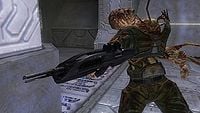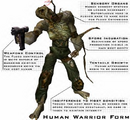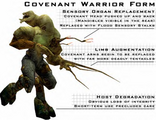Combat Form: Difference between revisions
From Halopedia, the Halo wiki
(we take the most updated pics) |
m (Reverted edits by Spartan781 (talk) to last version by Achronos-117) |
||
| Line 32: | Line 32: | ||
===Human Form=== | ===Human Form=== | ||
[[Image:Flood | [[Image:Flood human form.jpg|thumb|right|200px|A human combat form from Halo 2.]] | ||
The Human Combat Form is significantly smaller than other forms. As with other combat forms, it is capable of sustaining massive physical damage before being unusable to the Flood controller; in fact, as long as the chest cavity and legs remain intact, it will continue to fight. Although it cannot take as much damage as the Elite Combat Form can, it has some advantages. It seems more alert, and is quicker to melee an opponent. It also presents a smaller, harder to hit target, especially the Infection Form, as it isn't protruding out of the body as much as those of Elite Forms. They wield the weapons of former UNSC Marines and, if availible, those of the Covenant. They are also capable of driving vehicles such as [[Warthog]]s, [[Scorpion Tank]]s, and [[Ghost]]s. | The Human Combat Form is significantly smaller than other forms. As with other combat forms, it is capable of sustaining massive physical damage before being unusable to the Flood controller; in fact, as long as the chest cavity and legs remain intact, it will continue to fight. Although it cannot take as much damage as the Elite Combat Form can, it has some advantages. It seems more alert, and is quicker to melee an opponent. It also presents a smaller, harder to hit target, especially the Infection Form, as it isn't protruding out of the body as much as those of Elite Forms. They wield the weapons of former UNSC Marines and, if availible, those of the Covenant. They are also capable of driving vehicles such as [[Warthog]]s, [[Scorpion Tank]]s, and [[Ghost]]s. | ||
Revision as of 05:23, January 27, 2008
Template:Flood Species Infobox A Combat Form is a vertebrate suitable for combat that has been infected with the Flood parasite via an Infection Form and mutated into a combat unit that fights for Flood goals and objectives.
Pathology
A Combat Form is not a natural organism, but rather a mutated host infected by a parasitic Flood Super Cell implanted by an Infection Form. Successful creation of a combat form requries a host with sufficient biomass and calcium store. After mutation begins, the infection form attaches with a protruding neural connection that allows it to command the host's nervous system. During the infection process, the host's internal organs are liquefied and the nutrients from them are used to develop the tentacles and other appendages.
The host stays alive during the transformation process and is even conscious and aware after the final transformation. This process is presumably painful and terrifying. Once fully transformed, the infection form has total control over the host's body and changes the physical appearance of the host to better suit its own needs. (Although an infected host will be roughly the same size as it was before.) On rare occasions, this effect may be weakened by time in stasis, allowing the host to regain some control [1]. Combat forms retain the host's previous skills and so can wield weapons, drive vehicles and board enemy vehicles.
In the initial stage of a Flood Outbreak, the Feral Stage, Combat Forms communicate using pheromones and have one instinctual behavior: to secure new hosts to strengthen the local Gravemind. Once a sufficient store of biomass is available for the Flood to enter the Coordinated Stage and begin forming Pure Form Flood, the Combat forms are used either as defensive units or calcium/biomass reserves.
Eventually, a healthy Combat Form will mutate into a Carrier or Pure Form to perpetuate the Flood species. The Combat Form will prematurely transform if it takes so much damage that it cannot function effectively.
Flood infection is a rapid and efficient biological process, but an interesting side effect of the deadly human disease Boren's Syndrome, which Sergeant Avery Johnson suffered from, is total immunity to Flood super cells.
Types of Combat Forms
Not all organisms can be affected by the Flood. Of the various Covenant races, only a few species meet the necessary requirements. Species known to be immune to infection include the Lekgolo, whose segmented neural structure make synchronization impossible for Infection Forms, the Kig-yar whose avian bodies lack sufficient calcium stores, the Yanme'e whose chitinous shell makes infection impossible and the Huragok, which is artificial and therefore immune. Presumably, infinite possible host species exist. However, only three are seen in gameplay.
Human Form
The Human Combat Form is significantly smaller than other forms. As with other combat forms, it is capable of sustaining massive physical damage before being unusable to the Flood controller; in fact, as long as the chest cavity and legs remain intact, it will continue to fight. Although it cannot take as much damage as the Elite Combat Form can, it has some advantages. It seems more alert, and is quicker to melee an opponent. It also presents a smaller, harder to hit target, especially the Infection Form, as it isn't protruding out of the body as much as those of Elite Forms. They wield the weapons of former UNSC Marines and, if availible, those of the Covenant. They are also capable of driving vehicles such as Warthogs, Scorpion Tanks, and Ghosts.
Elite Form
During infection, the Elite's head is pushed backwards to create space for the infection form to reside. This Combat Form is a formidable enemy and is capable of a deadly physical attacks using whip-like tentacles. It can wield both human and Covenant weapons. It is very fast, very strong, and can jump great distances and heights. Some Elite combat forms can still use their armor's Active Camouflage and Energy Shields. Fortunately for the player, because of Elite physiology, they are bigger than the human form and present a larger target.
Brute Form
Brute Combat Forms behave much more aggressively in combat towards an opponent. During infection, the Infection Form burrows into their skulls and force the jaws apart to create a residual space. The creature seems to draw on its host's brutish nature and often forgo projectile weapons in favor of close combat. They usually wield Brute weapons such as Spikers, Maulers, and even Gravity Hammers, as well as more traditional Covenant weaponry and human armaments. However, they do not use the hammer to great effect, they just use it to melee instead of using the primary explosive hit. These creatures have not been seen controlling vehicles but it is possible since as Brutes can pilot Choppers and prowlers
Fighting a combat form
Combat Forms can take extensive damage before being neutralized. Arms, legs, even heads can be totally blown off before they are incapacitated. The weak areas of a Combat Form are its sensory appendages that normally develop on the upper chest. This is where the Infection Form has nestled, and the body is incapacitated if this area is destroyed by a projectile weapon. In all three Halo games, a Combat Form may fall only to stand up again and keep fighting. This can only happen if it still has a usable limb. In Halo 2 and 3, if the body is not destroyed, such as by an Energy Sword, Grenade or Brute Shot blade, Combat Forms can be revived by other Infection Forms crawling into it.
Human weapons are generally more effective against the Flood. Covenant plasma weaponry is designed to debilitate by causing burning pain and structural damage to bodies, but the Flood cannot feel pain or be crippled. Piercing weapons such as the Sniper Rifle have little effect on combat forms. However, they can be killed with sufficient force from projectile and melee weapons. Explosives such as grenades, rocket launchers, and the Brute Shot can easily kill a combat form. Plasma or Spike grenades should be used with caution, as the Combat Form will sometimes ignore all other targets and charge players using those weapons at high speed.
The Needler can be devastating, as the seven-needle explosion will prevent it coming back to life in Halo: Combat Evolved, and will shatter it in Halo 2 and 3. At close range the Shotgun, Mauler, Brute Spiker and Energy Sword are the best weapons. At close to medium ranges the M6C Magnum and SMG are effective against combat forms due to their fast fire rate, as well as the Sentinel Beam due to its continuous fire and burning capabilities. At long range the BR55 Battle Rifle, Covenant Carbine, or the M6D can be used to fire two shots to the upper chest. Burning Flood forms is one of the most effective methods in any situation, as is destruction of the torso. In Halo 3, a melee to the body of a Combat Form will render it unusable to Infection Forms.
Harmless or Useful Combat Forms
- Main article: How to make Flood Friends
In Halo: Combat Evolved it is possible to remove both limbs from a Combat Form, rendering it harmless and even helpful. These forms will follow the player and "nestle" close to it in an attempt to attack. It is only necessary to remove the tentacled arm of the Combat Form if it is unarmed. If it has a weapon, both limbs must be removed. These forms can be used as effective shields and will often charge Covenant enemies as a distraction.
This bug was removed in Halo 2. Instead, removing both arms will cause the infection form to leave the damaged host in search of another. It is still possible to remove one arm if the Combat Form is not carrying a weapon. In Halo 3 removing the tentacled limb of an unarmed Combat Form causes it to melee the player.
Trivia
- Juggernaut, Flood Combat, and Tank Forms have a "mouth like" head, where the sensory tentacles are located.
- In all Halo games, Flood Combat Forms always hold the Shotgun with one hand, and fire it without pumping another round into the chamber. In Halo 1, they somehow manage to make the shotgun pump itself, hoever this may be due to a unseen tenitcal being used to put another round in.
- Sometimes Flood will wield flamethrowers if they are revived very near to one.
- In Halo 2 and Halo 3, all Flood Combat Forms retain more of the host's armor, such as chest plating. They were almost naked in Halo: Combat Evolved.
- In Halo 2, all the Flood infected Elites wear the armor of an Elite Minor, even on levels where no Minor Elites were found. In Halo 3, an infected Elite Ultra retains the appropriate armor of an Ultra, but reverts to that of a Minor when it is killed. In Halo 3, an infected Chieftain will turn into a Brute combat form with Minor Brute Armor on. These seeming errors were due to memory constraints and also represent the rapid increase of visual effects technology over the course of the development of the games.
- Occasionally, if a player throws a Plasma Grenade on a Combat Form it will charge, ignoring any other non-Flood targets. In Halo 3 they will jump away from grenades.
- During some parts of the Halo 2 levels with Flood combat forms some are seen rarely (and poorly) using snipers, suggesting that the forms feeler-based sensory would make using scope-based weapons pointless. On Legendary difficulty, however, these Combat forms are incredibly deadly as they can one-shot-kill the player with great accuracy while running around in darkness.
- Flood Combat Forms in Halo 3 can pick up weapons discarded by the player, i.e. Spartan Lasers, if there is any ammo/charge left in the weapon. Care should be taken when dropping these kinds of powerful weapons around Flood forms, as they might be used against you by revived Flood.
References
- FloodWeaponless05.jpg
- Ultra Flood Combat.jpg
- BRUTEBUDDY.jpg
- 1195430022 100.jpg
- SMGFlood.jpg
| |||||||||||||||||||||||||||||||||


